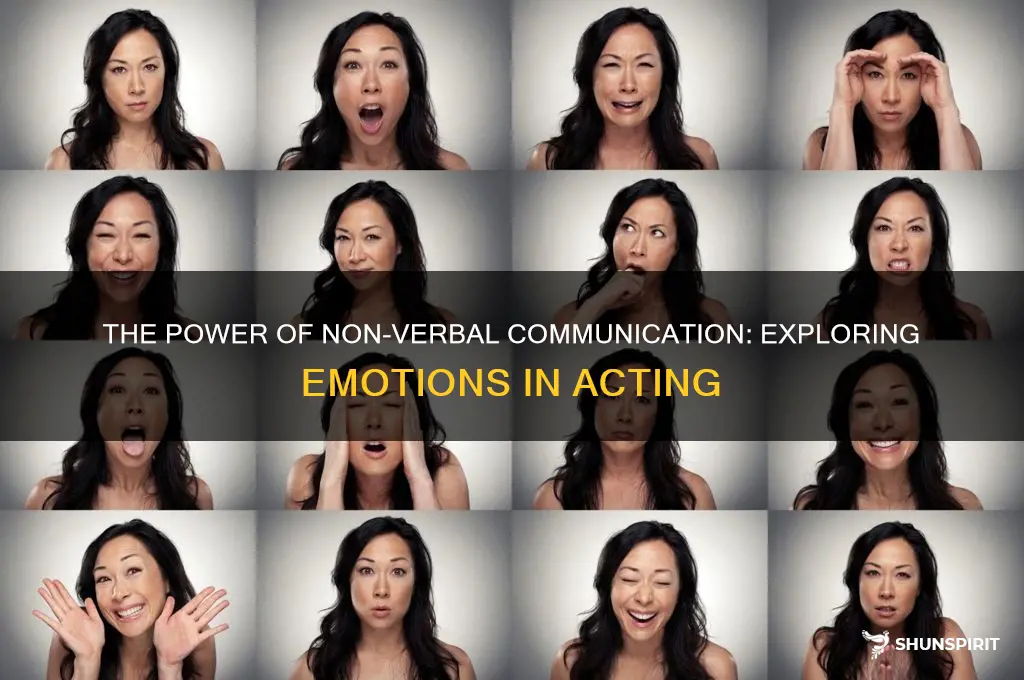
When it comes to acting, expressing emotions is a crucial aspect of bringing a character to life. While dialogue can communicate a character's feelings, non-verbal communication is equally important in conveying emotions on stage or screen. From facial expressions to body language, the art of expressing emotions non-verbally is a skill that requires observation, practice, and a deep understanding of human behavior. In this article, we will explore various techniques and tips for effectively showing emotions without words, and how it can enhance an actor's performance. So, sit back, relax, and get ready to dive into the world of non-verbal storytelling in acting.
| Characteristics | Values |
|---|---|
| Facial expressions | Happiness, sadness, anger, surprise, fear, disgust |
| Body language | Open or closed posture, gestures, stance |
| Eye contact | Direct or avoidant |
| Tone of voice | Loud or soft, confident or hesitant |
| Breathing patterns | Deep or shallow, fast or slow |
| Microexpressions | Brief and subtle facial expressions |
| Hand movements | Clenching or opening, pointing, waving |
| Proximity | Close or distant |
| Touch | Gentle or firm, comforting or aggressive |
| Overall energy | High or low, relaxed or tense |
| Intensity | Mild or strong, subtle or exaggerated |
| Timing | Quick or slow, delayed reactions |
| Consistency | Consistent or fluctuating |
| Congruence | Matching or conflicting with verbal expression |
| Environment | Adjusting to surroundings, adapting to atmosphere |
What You'll Learn

Non-Verbal Techniques for Expressing Emotions
Communication is not limited to just words; in fact, much of our understanding and expression of emotions comes from non-verbal cues. These non-verbal techniques include facial expressions, body language, gestures, and posture. Mastering these techniques can greatly enhance your ability to express and understand emotions accurately. In this blog post, we will explore each of these techniques in detail and provide some tips for effectively using them.
Facial Expressions:
Our faces are incredibly expressive and serve as a powerful tool for conveying emotions. Here are some key facial expressions and their meanings:
- Happiness: A genuine smile with raised cheeks and crinkled eyes.
- Sadness: A downturned mouth, droopy eyebrows, and watery eyes.
- Anger: A furrowed brow, clenched jaw, and narrowed eyes.
- Surprise: Raised eyebrows, widened eyes, and an open mouth.
- Disgust: A wrinkled nose, raised upper lip, and narrowed eyes.
- Fear: Wide eyes, raised eyebrows, and a tense mouth.
To express emotions effectively through facial expressions, remember to relax your face and focus on the specific muscles involved in each expression. Practice in front of a mirror to become more aware of your facial cues.
Body Language:
Our bodies can communicate just as much as our faces, if not more. Paying attention to body language can help you better understand others' emotions and allow you to express your own more effectively. Here are some examples of body language and their associated meanings:
- Openness: Uncrossed arms, relaxed posture, and facing others directly.
- Defensiveness: Crossed arms, tense shoulders, and leaning away from others.
- Confidence: Standing/sitting up straight, making direct eye contact, and using strong hand gestures.
- Nervousness: Fidgeting, avoiding eye contact, and standing/sitting with closed-off postures.
To use body language effectively, be mindful of your posture, hand movements, and overall body positioning. For example, if you want to appear confident during a presentation, maintain an open stance, use expressive gestures, and stand tall.
Gestures:
Gestures add another layer of communication to our non-verbal repertoire. They can help emphasize key points, express emotions, or illustrate ideas. Some commonly used gestures and their meanings include:
- Pointing: Indicating a specific person or object.
- Nodding: Signaling agreement or understanding.
- Thumbs up: Expressing approval or encouragement.
- Hand on heart: Showing sincerity or gratitude.
- Shrug: Signifying uncertainty or indifference.
When using gestures, be aware of cultural differences, as some gestures may have different interpretations in different cultures. Use gestures sparingly and purposefully to avoid distracting or confusing your audience.
Posture:
Your posture can speak volumes about your emotional state and how you perceive yourself. Here are a few types of posture and their associated meanings:
- Upward posture: Signifying confidence, openness, and engagement.
- Slouched posture: Indicating low confidence, disinterest, or tiredness.
- Closed-off posture: Crossing arms or legs, hunching shoulders, and avoiding eye contact, which may suggest defensiveness or discomfort.
To improve your posture, focus on sitting and standing straight with your shoulders back and your chin parallel to the ground. Practicing yoga or other exercises that improve core strength can also help maintain a healthy posture.
In conclusion, non-verbal techniques such as facial expressions, body language, gestures, and posture are powerful tools for expressing and understanding emotions. By mastering these techniques, you can enhance your communication skills and create more meaningful connections. Remember to practice them consciously and be aware of cultural differences to ensure effective communication in various contexts.
Understanding Emotional Intelligence: The Key Insight from Daniel Goleman
You may want to see also

Using Facial Expressions as a Tool for Emotional Acting
Facial expressions are a crucial tool for actors when it comes to portraying emotions on screen. The ability to effectively use facial expressions can make an actor's performance more authentic and engaging for the audience. In this blog post, we will explore the use of various facial expressions in emotional acting, including eye movements and brow furrowing, smiling and laughing, frowning and scowling, and crying and expressing sadness.
Eye Movements and Brow Furrowing
The eyes are often referred to as the "windows to the soul," and for good reason. They can convey a wide range of emotions, from happiness and excitement to fear and sadness. As an actor, it's important to be able to control your eye movements and use them to enhance your performance.
One effective technique is to focus your gaze on specific objects or people in the scene. This can help convey your character's intention or emotional state. For example, if your character is feeling curious or intrigued, you can widen your eyes and direct your gaze towards the object of interest. On the other hand, if your character is feeling suspicious or distrustful, you can narrow your eyes and shift your gaze away from the object.
Brow furrowing is another powerful facial expression that can convey a range of emotions, particularly those related to thoughtfulness, concern, and anger. To furrow your brows, simply bring them closer together, creating vertical lines on your forehead. This expression can be used to convey deep concentration, worry, or frustration. By practicing brow furrowing in front of a mirror, you can learn to control this movement and use it effectively in your acting.
Smiling and Laughing
Smiling and laughing are expressions associated with happiness, joy, and amusement. However, not all smiles are the same. Different types of smiles can convey different emotions and intentions. For example, a genuine smile, also known as a Duchenne smile, involves the contraction of the muscles around the eyes, creating crow's feet. This type of smile signals genuine happiness or amusement.
On the other hand, a fake smile, also known as a social smile, only involves the muscles around the mouth. This smile may be used when your character needs to appear polite or friendly, but is not genuinely happy. To effectively portray these different types of smiles, practice in front of a mirror and experiment with different muscle movements.
Similarly, laughing can also be adjusted to suit the specific emotional context of your character. A hearty laugh can convey genuine amusement, while a forced or nervous laugh can indicate discomfort or unease. It's important to practice different types of laughs and vary your vocalization to make your performance more believable.
Frowning and Scowling
Frowning and scowling are facial expressions commonly associated with anger, frustration, or disapproval. These expressions involve the downward movement of the eyebrows and the tightening of the muscles around the eyes and mouth.
To effectively convey these emotions, practice furrowing your eyebrows and tightening the muscles in your face. Experiment with different intensities and durations to create the desired effect. Additionally, pay attention to your body language, as frowning and scowling are often accompanied by tense body postures.
Crying and Expressing Sadness
Crying is a powerful way to convey intense sadness or grief. As an actor, being able to cry on cue can be a valuable skill. However, crying convincingly requires more than just producing tears. It involves embodying the character's emotions and allowing them to wash over you.
To evoke tears, you can use various techniques, such as thinking of personal experiences that elicit sadness, or using visualization exercises. In addition to tears, other facial expressions, such as trembling lips or quivering chin, can enhance the portrayal of sadness. Practice these expressions in front of a mirror to refine your technique.
In conclusion, facial expressions play a crucial role in emotional acting. By mastering the use of eye movements and brow furrowing, smiling and laughing, frowning and scowling, and crying and expressing sadness, actors can create more authentic and engaging performances. Remember to practice these expressions in front of a mirror, experiment with different intensities, and pay attention to your body language to make your acting more compelling.
Understanding Emotional Intelligence: What Percentage of Teens Are Adept?
You may want to see also

Conveying Emotions through Body Language and Gestures
Body language and gestures are powerful tools for conveying emotions and intentions. Whether you are engaged in a conversation, giving a presentation, or trying to establish rapport with someone, understanding and utilizing effective body language can significantly enhance your communication skills. In this blog post, we will explore various aspects of body language and gestures that can help you convey your emotions more effectively.
Open and Closed Posture:
Your posture plays a crucial role in conveying your emotions. An open posture indicates friendliness, approachability, and attentiveness. It involves keeping your body relaxed, with your arms uncrossed and your chest open. This posture signals that you are receptive to others and encourages open communication.
On the other hand, a closed posture, with crossed arms and a hunched back, conveys defensiveness, discomfort, or disinterest. This posture creates a barrier between you and others, hindering effective communication. To convey positive emotions, consciously maintain an open posture and be aware of any defensive or closed-off body language.
Hand Movements and Gestures:
Our hands are a powerful tool for expressing emotions and emphasizing key points. When you speak, use appropriate hand movements and gestures to enhance your message. For example, waving your hands gently can convey excitement or enthusiasm, while using your hands to illustrate or emphasize specific points can make your message more engaging and memorable.
However, it's essential to strike a balance. Excessive hand movements can be distracting and may convey nervousness. Similarly, keeping your hands hidden or tensed can give off the impression of insincerity. Practice using natural and purposeful hand movements that align with your emotions and the meaning you want to convey.
Body Tension and Relaxation:
The level of body tension you convey can greatly impact how others perceive your emotions. When you are tense, whether due to stress, nerves, or discomfort, it can be transmitted through your body language, hindering effective communication.
To convey positive emotions, aim to relax your body and relieve tension. Focus on your breathing, and consciously release any held tension in your muscles. This will not only make you feel more at ease but also signal to others that you are approachable and open to communication.
Mirroring and Matching Movements:
One effective way to establish rapport and connect with others is by subtly mirroring or matching their movements. This technique involves imitating the other person's body language, gestures, and even their breathing patterns to create a sense of shared understanding and empathy.
When used authentically, mirroring and matching can foster a deeper connection and help convey your emotions more effectively. It's important to remember that this technique should be subtle and not overtly mimicry. Gradually and subtly align your body language with the other person to establish rapport and convey your emotions in a more synchronized manner.
In conclusion, mastering the art of body language and gestures can significantly enhance your ability to convey emotions effectively. By consciously adopting an open posture, using appropriate hand movements and gestures, relieving body tension, and incorporating mirroring and matching techniques, you can create a more engaging and authentic communication experience. Remember, practice is key, so make an effort to observe and analyze your own body language and gestures to continually improve your nonverbal communication skills.
Defeating Procrastination: Harnessing the Power of Emotional Intelligence
You may want to see also

Enhancing Emotional Acting with Physicality and Energy
Acting is a craft that goes beyond delivering lines and embodying a character. To truly create a compelling and believable performance, actors need to tap into their emotions and explore physicality and energy. In this blog post, we will delve deeper into how to enhance emotional acting through physicality and energy.
Physicality in Movement:
Physicality in movement refers to using the body to express emotions and convey the inner world of the character. It is important to understand the character's physicality in terms of posture, gestures, and overall movement. For example, a character who is confident and powerful might have a strong and assertive posture, while a character who is shy and introverted might have a more closed-off and timid body language.
To enhance physicality in movement, actors can focus on embodying the character's emotions through their body. They can experiment with different postures and gestures that reflect the character's inner state. For instance, if the character is angry, the actor might use expansive and forceful movements, while if the character is sad, the actor might exhibit slower and more subdued movements.
Energy Levels and Dynamics:
Energy levels and dynamics play a crucial role in portraying emotions effectively. Different emotions require different levels and qualities of energy. For instance, anger requires a higher energy level with more intensity, while sadness might require a lower energy level with a sense of heaviness.
Actors can enhance their emotional acting by exploring the energy levels and dynamics of their character. They can start by understanding the emotional arc of their scene or monologue and adjust their energy accordingly. For example, if the scene begins with a calm and peaceful mood, the actor can start with a neutral energy level and gradually increase it as the scene progresses and intensifies.
Using Space and Levels:
Using space and levels can greatly enhance emotional acting. By moving around the space and utilizing different levels, actors can add depth and dimension to their performances. They can create a sense of urgency, intimacy, or power by appropriately utilizing the available space.
For instance, if a character is feeling trapped or confined, the actor can physically limit their movement and stay in a smaller space. On the other hand, if a character is feeling liberated or triumphant, the actor can utilize the entire space and move freely. Similarly, using different levels, such as sitting, standing, or kneeling, can convey different emotional states and power dynamics.
Breath Control and Voice Modulation:
Breath control and voice modulation are essential tools for enhancing emotional acting. Breathing deeply and consciously can help actors connect with their emotions and ground themselves in the present moment. This, in turn, allows for a more authentic and organic performance.
Additionally, actors can use breath control to modulate their voice and effectively convey the emotions of the character. They can experiment with different breath patterns, pace, volume, and tone to match the emotional landscape of the scene. For example, if the character is anxious, the actor can use shallow and rapid breaths to convey the character's heightened state.
In conclusion, enhancing emotional acting with physicality and energy requires actors to delve deep into their characters' inner worlds and creatively express their emotions through movement, energy, space, and voice. By exploring these elements and utilizing them effectively, actors can create powerful and compelling performances that resonate with audiences. So, go ahead, dive into your characters, and bring them to life with your physicality and energy!
Navigating Conversations with an Emotional Abuser: Key Strategies to Safeguard Your Mental Health
You may want to see also
Frequently asked questions
To show happiness non verbally for acting, you can use facial expressions such as a wide smile, raised eyebrows, and sparkling eyes. You can also use body language like exuberant gestures, jumping or skipping, and an upright and open posture. Additionally, incorporating a lively and energetic tone of voice can further convey the emotion of happiness.
To show sadness non verbally for acting, you can use facial expressions like a downturned mouth, drooping eyebrows, and teary or puffy eyes. Slowed movements and a slouched or hunched posture can also help convey a sense of sadness. Additionally, speaking with a soft and melancholic tone of voice can further enhance the portrayal of this emotion.
To show anger non verbally for acting, you can use facial expressions like a furrowed brow, narrowed eyes, and clenched jaw. Tense body language, such as crossed arms, a rigid stance, and aggressive gestures, can also convey anger. Additionally, speaking with a loud and intense tone of voice, emphasizing harsh or aggressive words, can further display this emotion.
To show fear non verbally for acting, you can use facial expressions like widened eyes, raised eyebrows, and a tensed jaw. Trembling or frozen movements, a hunched or crouched posture, and a quickened pace can also help convey a sense of fear. Additionally, speaking with a shaky or breathless tone of voice can further enhance the portrayal of this emotion.







